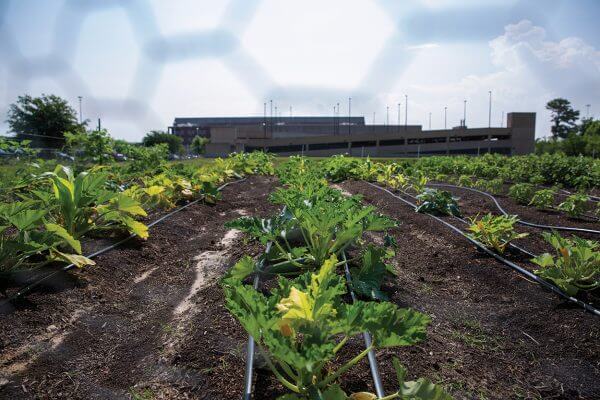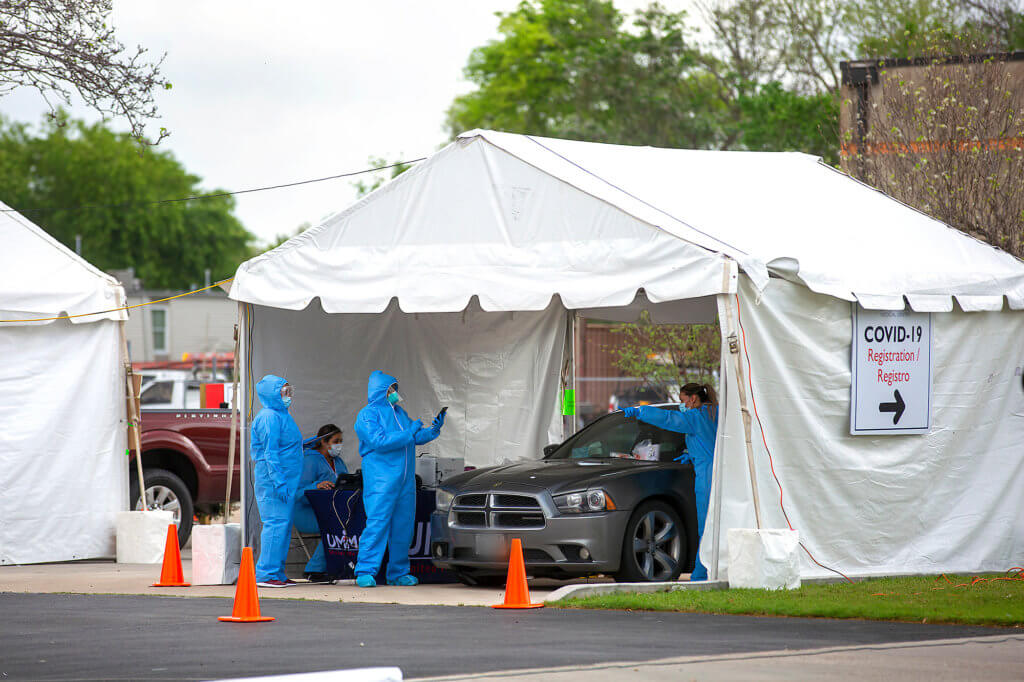Cultivating a food farmacy

Rows of tomatoes, peppers, strawberries, green beans and other plants are thriving on a small farm just behind Lyndon B. Johnson Hospital, Harris Health System’s Level III trauma center in northeast Houston.
The community farm program, in development for the past year, aims to provide fruits and vegetables to patients and community members with limited access to grocery stores that stock fresh produce. Distribution details are still in the planning stages.
“Sometimes what our patients most need is to be prescribed a plate of healthy food—more than medication and the downstream management of that chronic disease burden,” said Karen Tseng, senior vice president of population health transformation at Harris Health System. “If we could get at the root cause, upstream, and help support them earlier in the process, evidence has shown, we can actually improve community health outcomes.”
Residents of the Fifth Ward and northeast quadrant of Harris County, where the hospital is located, have long struggled with food insecurity. The U.S. Department of Agriculture considers the area a food desert—a place lacking in fresh fruits, vegetables and other healthful whole foods—and Harris Health estimates more than 13,000 residents suffer from hunger daily.

Rows of zucchini thrive on the community farm outside of LBJ Hospital. The farm could yield as much as 500 pounds of produce a week.
“This community doesn’t have a lack of knowledge of what they need to do, they have a lack of access,” said Michelle Seitzinger, director of nursing and manager of the community farm program at LBJ Hospital. “Diabetes and high blood pressure are the biggest problems our population is facing. These conditions are not uncommon, but the biggest difference in our community is that our patients don’t have access to a grocery store.”
The lack of accessible fresh food coupled with the fact that many residents rely on public transportation means that many people buy meals at convenience stores, she added. It’s also challenging for patients to get from their homes to LBJ Hospital.
“Many of our patients rely on the METRO bus route for transportation,” Seitzinger said. “The problem is that there are multiple stops between their home and their destination. They might have to walk a couple of miles to get to the bus stop and then that bus makes four different stops until it comes to LBJ.”
Thinking outside the box
To fight food insecurity in the area, Harris Health executives decided to create a farm and hired Rebecca Verm, full-time, to oversee it. Verm is a native Houstonian who graduated from The University of Texas at Austin with a degree in philosophy.
“I began farming over a decade ago because I want to make agriculture real and accessible to everybody,” Verm said. “I just never in my life imagined that a county-run hospital in Houston, Texas of all places—oil and gas, hospital central—would think this outside of the box.”
Creating a farm within a hospital has been a dream of Verm’s since a conversation she had with her brother, a surgical resident at the University of Southern California. When her brother came back from a trip to India a few years ago, he told her they should open a hospital or clinic with a farm attached, because that is the only way people are going to be able to transform health care into a culture of health.
“When I sat down and talked to Alan Vierling [former executive vice president and administrator of LBJ Hospital] about why he created this vision for the farm and had come to the realization that this is what needs to happen in order to take health care to the next step, it brought me right back to that conversation with my brother—and I had to say yes,” Verm said.
But at one acre, the LBJ Hospital farm simply cannot produce enough food to feed the patients and staff at the 207-bed hospital. Instead, leaders are using the farm as a hub to host programming about produce, healthy eating and wellness.
“We would love to be able to grow our farm to serve the LBJ cafeteria and to service more hospital cafeterias,” Verm said. “We could feasibly provide enough food for the LBJ hospital cafeteria by utilizing hospital roof spaces and turning them green. If done the right way, that could reduce the hospital’s utility costs and you can grow very efficiently in vertical gardens.”
Currently, the farm is harvesting 50 to 65 pounds of fresh produce weekly. At full production, Verm estimates the farm will produce about 500 pounds a week.
“All of our produce is going to be donated and the donations are just to get people’s feet in the door,” Verm said. “Being able to feed and supply people with good, fresh vegetables is not going to be necessarily this farm’s responsibility, but we, as stewards, want to help collaborate with other organizations to get more farmers and develop more farms so they can actually be the ones who are feeding the community.”

Farmer Rebecca Verm harvests Shungiku chrysanthemum flowers to dehydrate for teas at the LBJ Hospital farm.
Measuring clinical outcomes
Eventually, the produce harvested on the farm will be coupled with fresh food from the Houston Food Bank and distributed to patients with diabetes, hypertension, and possibly expectant mothers through a hospital-based “food farmacy.”
Hospital administrators will be measuring certain biomedical markers to ensure patient health outcomes are improving because of the food.
“We are measuring clinical outcomes—A1C levels [which calculate blood sugar], LDL [low-density lipoproteins, also known as “bad” cholesterol] and blood pressure reduction,” Tseng said.
According to Tseng, a one-point reduction in a patient’s A1C levels translates to a savings of about $8,300 for the hospital by avoiding unnecessary medical services.
“We hope to share results in the next six months to one year to see to what extent those three biomedical markers improve, each point of which directly translates into cost savings,” Tseng said. “We are also measuring outcomes related to knowledge and fruit and vegetable consumption, so we are looking over time to see if patients’ diets shift to more fruits and vegetables and measuring patient and partner satisfaction.”
Hospital administrators also hope to offer “walk-and-learn” sessions with patients, during which dietitians lead participants through the farm and teach them about food selection and its impact on health. Physical therapists are also looking at the farm space to conduct sessions with their patients using benches and a walking path that will soon be completed.
“Access to high-quality clinical care is very important to total health, but it is just one piece of the
puzzle,” Tseng said. “It is responsible for about 20 percent of health outcomes, another 30 percent is behavioral and a whopping 50 percent is due to the social determinants of health—of which poverty is a huge predictor.”
Although in its infancy, the farm to hospital initiative has already received national attention. The program recently won the American College of Physicians 2019 Innovation Challenge grand prize, which came with a $20,000 grant. The Texas Medical Center provided $150,000 in grants to Harris Health and The University of Texas MD Anderson Cancer Center to support development of the farm and its programming.
“It is going to prove to countless other counties and hospitals across the country, hopefully around the world, that this is not a pipe dream, this is not a froufrou, cute and nice thing, but that this can be a real game changer of public health intervention,” Verm said.
In addition to growing healthy food for their hospital patients, Verm and Seitzinger have committed themselves to creating change in the Fifth Ward. The two have partnered with neighborhood leaders to bring local children to the farm, educate community members about the importance of fresh food and help solve the problem of access to fresh produce.
“I would love it if all of the students who come out here all wanted to be farmers, but that’s not the reality of the situation,” Verm said. “More than wanting them to grow up to be farmers, I want them to grow up to be teachers, doctors, politicians, leaders and activists who all have something grounded in respect for agriculture and the need for healthy, nourishing food.”




